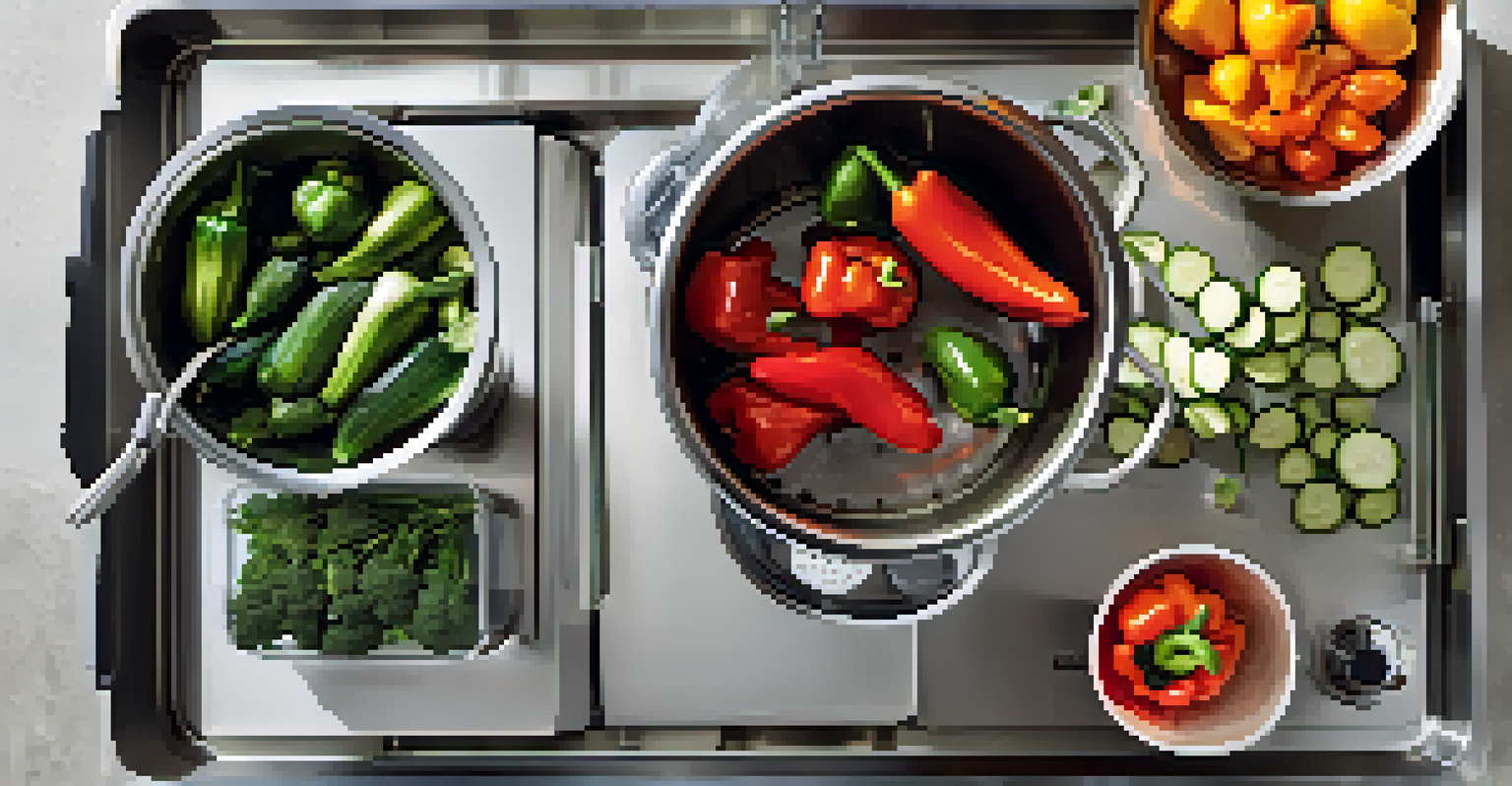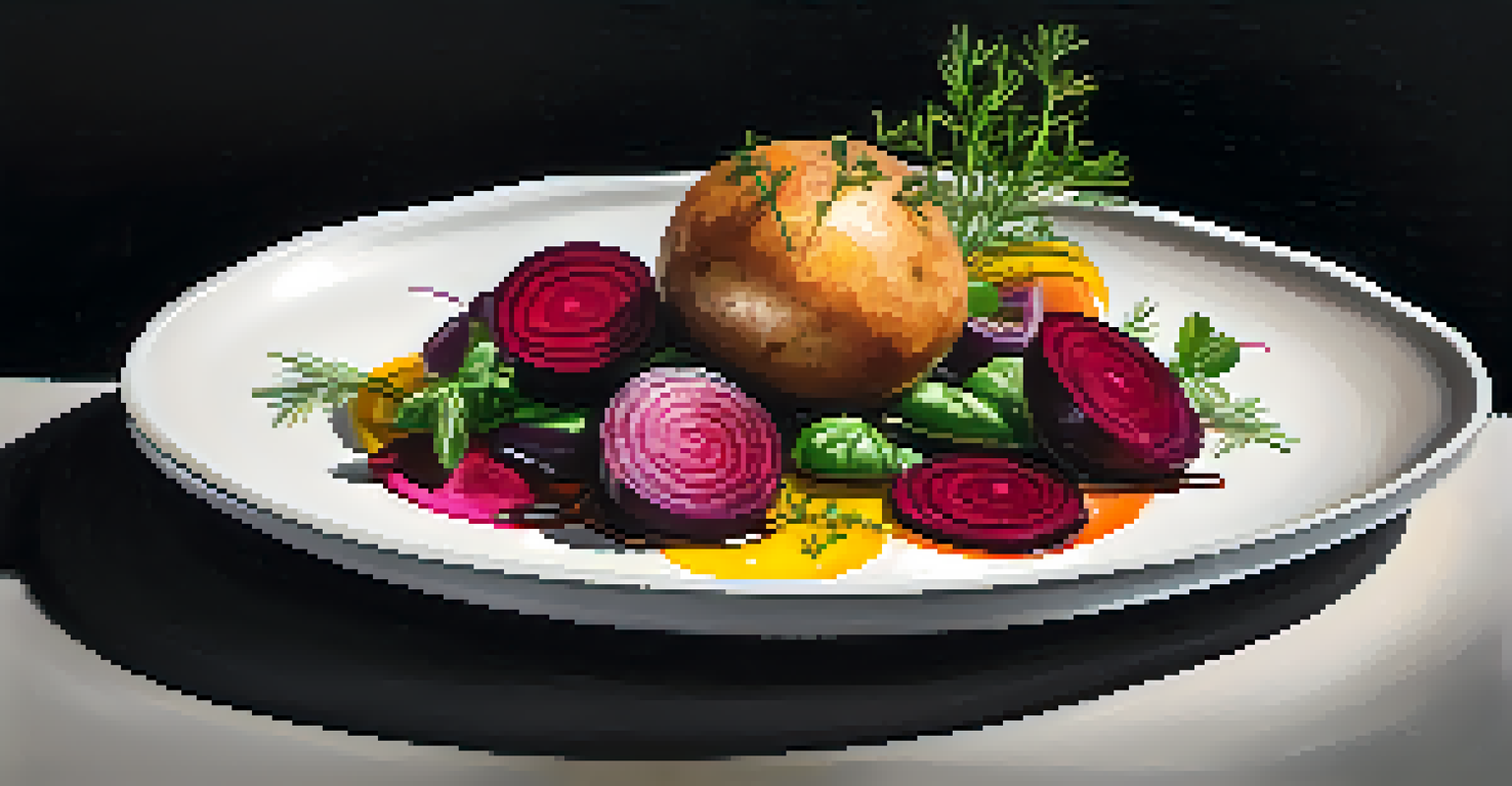Sous Vide Cooking: Techniques for Perfectly Cooked Veggies

What is Sous Vide Cooking and Its Benefits for Veggies?
Sous vide cooking is a method where food is vacuum-sealed and cooked in a water bath at a precise temperature. This technique allows for even cooking, which is especially beneficial for vegetables, ensuring they retain their vibrant color and nutrients. The gentle heat means you can achieve a perfect texture without the risk of overcooking.
Cooking is like love. It should be entered into with abandon or not at all.
Imagine cooking carrots until they are tender yet still crisp, or turning asparagus into a melt-in-your-mouth delight. With sous vide, you have full control over the cooking process, which is a game changer for home cooks looking to elevate their vegetable dishes. Plus, since the veggies are sealed in bags, they absorb flavors from herbs and spices beautifully.
Ultimately, sous vide cooking bridges the gap between ease and gourmet results. Whether you're preparing a simple side or an elaborate dish, this technique can transform your vegetable cooking experience.
Essential Equipment for Sous Vide Cooking
To dive into sous vide cooking, you'll need a few essential pieces of equipment. The cornerstone is a sous vide immersion circulator, which regulates the water temperature. There are also vacuum sealers that help you package your veggies properly, ensuring minimal air exposure during cooking.

Don’t worry if you don’t have a vacuum sealer; you can also use zip-top bags and the water displacement method to remove air. Just submerge the bag in water and seal it just before it’s fully submerged to push out the air. This simple trick makes sous vide accessible to everyone, regardless of their kitchen setup.
Sous Vide Enhances Veggie Flavor
Sous vide cooking allows vegetables to retain their nutrients and vibrant colors while absorbing flavors from herbs and spices.
Lastly, a large container or pot is necessary to hold the water bath, and a thermometer is useful for checking temperatures if you’re using a pot without a built-in gauge. With these tools in hand, you're ready to explore the delicious world of sous vide cooking!
Choosing the Right Vegetables for Sous Vide
Not all vegetables are created equal when it comes to sous vide cooking. Hardy vegetables like carrots, potatoes, and beets hold up well to the process and can benefit significantly from the precise temperature control. On the other hand, delicate veggies like spinach or lettuce may not require sous vide at all, as they can wilt quickly.
The secret of good cooking is, first, having a good dish; second, a good cook; and third, a good fire.
Consider the cooking times and temperatures for each type of vegetable. For instance, root vegetables often need longer cooking times compared to softer options like zucchini or bell peppers. A general rule of thumb is to cook denser veggies at higher temperatures for longer, while more tender ones can cook at lower temperatures for shorter periods.
Experimenting with different vegetables is part of the fun! You may discover surprise favorites that come out perfectly cooked and bursting with flavor.
How to Season Vegetables for Maximum Flavor
One of the joys of sous vide cooking is the ability to infuse your vegetables with flavors before the cooking process begins. Since the veggies are sealed in bags, they can absorb seasonings like herbs, spices, and oils more intensely. A simple combination of olive oil, garlic, salt, and pepper can transform ordinary vegetables into something extraordinary.
Don’t shy away from experimenting with marinades or adding fresh herbs like thyme, rosemary, or basil. You can create vibrant flavor profiles that complement the natural taste of each vegetable. Remember, seasoning can be adjusted based on personal preference, so feel free to get a bit creative!
Essential Tools for Sous Vide
Key equipment for sous vide cooking includes an immersion circulator, vacuum sealer, and a large container for the water bath.
Also, consider adding a squeeze of lemon or a splash of vinegar after cooking to brighten the flavors. This little trick can elevate your dish and provide a delightful contrast to the richness of the cooked veggies.
Setting the Right Temperature and Time for Vegetables
Timing and temperature are crucial components of sous vide cooking. Each vegetable has an optimal cooking time and temperature that ensures it reaches the perfect texture while retaining its nutrients. For instance, carrots are typically cooked at 183°F (84°C) for about 1 to 1.5 hours for a tender yet slightly crisp bite.
On the flip side, softer vegetables like bell peppers might only need around 30-45 minutes at 183°F (84°C). It’s essential to consult a reliable sous vide cooking chart to find these specifics, as getting these factors right can make or break your dish.
And the beauty of sous vide is that even if you cook your veggies longer than intended, they won't overcook as they would with traditional methods. This flexibility allows you to focus on other meal preparations without the constant worry of checking on your veggies.
Post-Cooking: Finishing Techniques for Sous Vide Veggies
Once your vegetables are cooked sous vide, there are several finishing techniques to enhance their flavor and appearance. A quick sear in a hot pan can add a delightful caramelization and texture that contrasts with the tender interior. Just a minute or two per side is often enough to achieve that golden-brown finish.
Alternatively, you could grill the veggies for an added smoky flavor or roast them in the oven to enhance their sweetness. Each technique brings a unique twist, so feel free to choose based on the dish you’re creating.
Perfect Timing and Temperature
Getting the right cooking time and temperature is crucial for achieving the perfect texture in sous vide vegetables.
Remember, finishing isn’t just about aesthetics; it also adds depth to the flavor profile. A sprinkle of sea salt or a drizzle of balsamic glaze can elevate the dish, making it not only delicious but also visually appealing.
Serving Suggestions and Pairings for Sous Vide Veggies
Once your sous vide veggies are ready, it’s time to serve them! These beautifully cooked vegetables can be enjoyed on their own or as part of a more extensive meal. Consider pairing them with grilled meats, fish, or even as a vibrant base for a grain bowl.
You can also toss them into salads for a delightful texture contrast or blend them into purees for a comforting soup. The versatility of sous vide veggies means they can fit into any meal, making them an excellent choice for weeknight dinners or special occasions.

Finally, don’t forget about garnishing! Fresh herbs, a sprinkle of cheese, or toasted nuts can add flavor and texture that will impress your guests. The possibilities are endless, allowing you to get creative with your presentations.